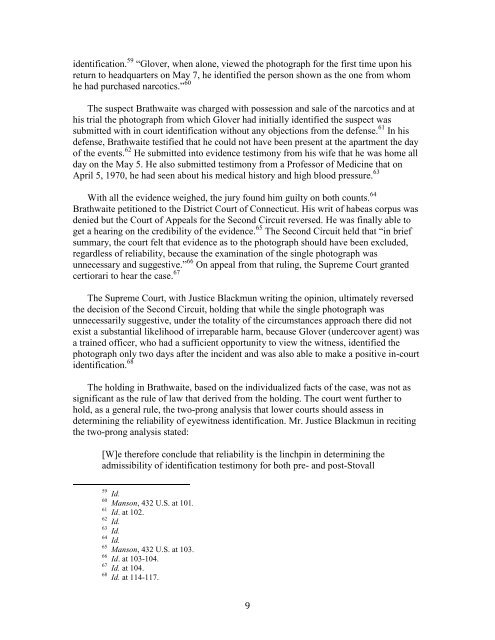dada_floridamisidentification_final - UDC Law Review
dada_floridamisidentification_final - UDC Law Review
dada_floridamisidentification_final - UDC Law Review
- No tags were found...
Create successful ePaper yourself
Turn your PDF publications into a flip-book with our unique Google optimized e-Paper software.
identification. 59 “Glover, when alone, viewed the photograph for the first time upon hisreturn to headquarters on May 7, he identified the person shown as the one from whomhe had purchased narcotics.” 60The suspect Brathwaite was charged with possession and sale of the narcotics and athis trial the photograph from which Glover had initially identified the suspect wassubmitted with in court identification without any objections from the defense. 61 In hisdefense, Brathwaite testified that he could not have been present at the apartment the dayof the events. 62 He submitted into evidence testimony from his wife that he was home allday on the May 5. He also submitted testimony from a Professor of Medicine that onApril 5, 1970, he had seen about his medical history and high blood pressure. 63With all the evidence weighed, the jury found him guilty on both counts. 64Brathwaite petitioned to the District Court of Connecticut. His writ of habeas corpus wasdenied but the Court of Appeals for the Second Circuit reversed. He was <strong>final</strong>ly able toget a hearing on the credibility of the evidence. 65 The Second Circuit held that “in briefsummary, the court felt that evidence as to the photograph should have been excluded,regardless of reliability, because the examination of the single photograph wasunnecessary and suggestive.” 66 On appeal from that ruling, the Supreme Court grantedcertiorari to hear the case. 67The Supreme Court, with Justice Blackmun writing the opinion, ultimately reversedthe decision of the Second Circuit, holding that while the single photograph wasunnecessarily suggestive, under the totality of the circumstances approach there did notexist a substantial likelihood of irreparable harm, because Glover (undercover agent) wasa trained officer, who had a sufficient opportunity to view the witness, identified thephotograph only two days after the incident and was also able to make a positive in-courtidentification. 68The holding in Brathwaite, based on the individualized facts of the case, was not assignificant as the rule of law that derived from the holding. The court went further tohold, as a general rule, the two-prong analysis that lower courts should assess indetermining the reliability of eyewitness identification. Mr. Justice Blackmun in recitingthe two-prong analysis stated:[W]e therefore conclude that reliability is the linchpin in determining theadmissibility of identification testimony for both pre- and post-Stovall59 Id.60 Manson, 432 U.S. at 101.61 Id. at 102.62 Id.63 Id.64 Id.65 Manson, 432 U.S. at 103.66 Id. at 103-104.67 Id. at 104.68 Id. at 114-117.9














